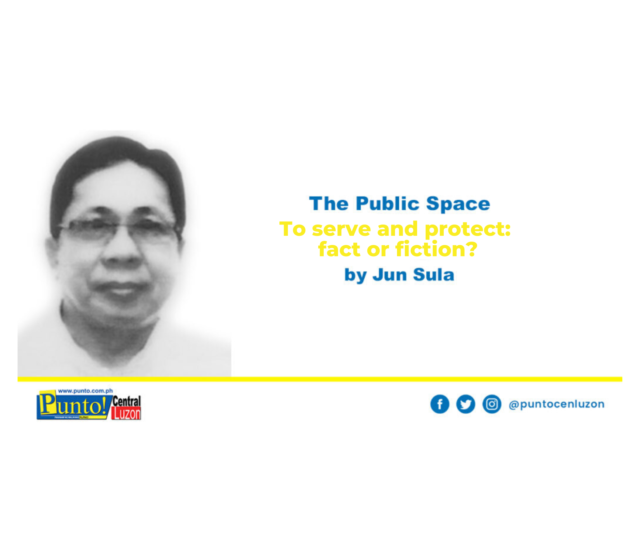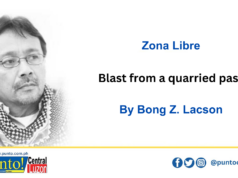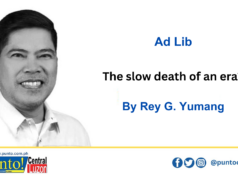One day when I was working for the late Gov. Bren Z. Guiao at the provincial capitol, I got a frantic phone call from a cousin. His older brother, he said, was manning traffic somewhere in Balibago, Angeles City.
It was high noon. But the scorching sun was not his problem. His brother was not a cop. And he was directing traffic in his birthday suit. He was not a frat member either under initiation; he was suffering from a mental illness. An ambulance was needed to bring him to a mental hospital immediately.
He was an Army soldier during the Marcos regime. He was assigned in Mindanao to fight against the secessionist rebels. He was later discharged , presumably because he was declared no longer fit for the job. He probably suffered from post traumatic stress disorder (PTSD) like Army soldier Winston (he must have been named after Churchill, a hint of a sense of nobility) Ragos who was recently shot dead by a cop manning a checkpoint.
Through the help of some people, my cousin was able to extract his brother from the public scandal. I was able to borrow an ambulance from Barangay Captain Martinez of San Fernando which brought my ill cousin to Mariveles, Bataan. He died a few years later, partly because of the effect of PTSD, at still a young age, leaving behind several minor children.
The other day, I was listening to an American pastor on Youtube who told of a fiction he saw on TV about an old war veteran who was losing it. The veteran had committed a crime and soon cops descended on his house to arrest him.
The cops were armed and bigger than the veteran, he said. As the cops were about to lay their hands on the poor vet, a neighbor suddenly stepped in, opened the man’s shirt and showed a round metal object hanging on his chest.
To a man, the cops suddenly gave the veteran a snap salute. The metal object on his chest turned out to be a medal for heroism.
In the real world, how do you deal with person who seems to pose a threat to life and limb but turns out to be some kind of a hero for fighting a war that gave the mental illness that he suffers from?
Before he was shot, Ragos reportedly told the cops at the nearby checkpoint that he was soldier, or a former one. Minutes prior to being shot at a relatively close range, bystanders were pleading to the cops not to shoot him because he was mentally sick. One of them shot him, anyway.
On CNN, Philippine National Police Chief Archie Gamboa, a lawyer-general, described it as a judgment call.
I searched for a definition of a judgment call, and here is a good one: a judgment call is a decision made when there are no firm rules or principles that can help you make it, so you have to rely on your own judgment and instinct.
The definition resonates with a first hand experience I had two decades ago. I was working in a government agency for disaster victims. At one time, my boss wrote a marginal note on the voucher of a check payment for a landowner. The note read: do not release check unless requirements are completed.
Inspite of the note, an officer of the agency released the check to the payee, contravening the boss’ clear instruction. When the fate of the erring officer was discussed in a meeting, the boss described the faux pas as simply a judgment call.
I disagreed: the instruction was clear as day and could not be interpreted any other way.
In the Ragos case, a commissioner of the National Police Commission said that part of a cop’s responsibility is to save lives. You don’t go and kill him right away, you can disable him, which he said should have been done in this case. As it turned out, Ragos was shot in the body first to kill him before being hit in another part to disable him. Besides, when Ragos turned his back on cops, they could have easily overpowered him and wrestle him to the ground.
At the height of the Duterte drug war when civilians were being killed left and right because they were allegedly armed, former President Ramos reminded the police that the rules of engagement calls for disabling not immediately killing.
Granting that it was a judgment call, the next thing to do now is to determine whether it was a right judgment or not based on the surrounding circumstances.
In the NBA and the PBA, referees make judgment calls that a slow-mo review later would show it was the wrong call. There were times when the leagues would confirm that it indeed it was a wrong whistle. (Sometimes, the referres would make inadvertent or accidental whistles.) The call stuck but the damage had been done.
And then, there is this overarching rule you see at Camp Crame or at police stations: to serve and protect. Is this merely an ethical suggestion or a moral command that must be observed by every cop. How well is this imbibed by everyman who wears the PNP badge and uniform?
Whenever I pass checkpoints this ECQ days, I see cops in some checkpoints brandishing small sticks as if they were meant for use against ECQ violators, as if their intimidating presence in fatigue uniforms and displaying long firearms are not enough. Is this consistent with the police policy to serve and protect?
During the time of President Ramos, I remember a moral recovery program was launched for the country’s police force. The title hinted at a problem in the PNP at the time. Nothing was heard about it since.
Newly-reminted Presidential Spokeperson Harry Roque was quick to disabuse any notion that Duterte’s earlier order to cops to shoot unruly violators of the lockdown had anything to do with the Ragos’s fate.
That’s a fair thing to ask, but a naive one, if not a dishonest claim. He’s, in effect, saying that a presidential statement cannot influence anybody or any event. Or words are powerless. That’s quite a leap into the abyss.





